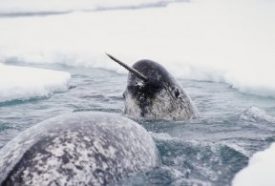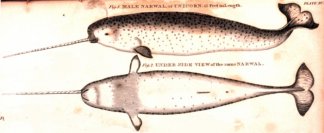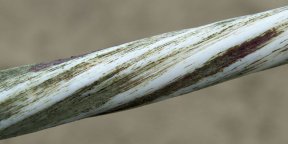A whale’s amazing tooth
The narwhal's long tusk may sense changes in water temperature and pressure, helping the sea animal survive in the Arctic.
By Emily Sohn
The narwhal looks as if it belongs in a fairy tale. Or maybe a myth. This unusual whale has a long, straight tooth, or tusk, that resembles the horn of a unicorn.
 |
|
The narwhal’s tusk may serve as a temperature or pressure sensor.
|
| Photo by Glenn Williams |
Most male and some female narwhals have such a tusk. It sticks out from the left side of the animal’s upper jaw and may grow up to 8 feet long. Not counting the tusk, a narwhal’s body is typically 13 to 15 feet long. Most narwhals weigh more than a ton.
You’ll probably never see a narwhal in person because these animals live in the frigid waters of the Arctic Ocean. And no zoo has ever managed to keep a narwhal alive for long.
Narwhal tusks have inspired legends, but scientists know very little about these creatures. And no one has ever come up with a good explanation for why narwhals have such bizarre teeth.
 |
|
This illustration from an 1820 book shows two views of a male narwhal.
|
| NOAA Photo Library |
“It’s been a scientific mystery for a couple hundred years,” says Martin Nweeia, a dentist in Sharon, Conn., and a researcher at the Harvard School of Dental Medicine. “All kinds of explanations have been proposed, but none has been widely accepted.” Suggested uses for the tusk include breaking ice, spearing fish, attracting a mate, or defending against a predator.
To find out the tusk’s purpose, Nweeia and his coworkers are, for the first time, doing detailed studies of fresh tusks rather than of dried tusk tissue. This work is turning up surprising information about the tooth’s structure and is hinting at a most unusual use: The scientists now say that the tusk might serve as a temperature, pressure, or water-quality sensor.
Arctic expeditions
When Nweeia first proposed the narwhal-tusk project 5 years ago, he had no idea what to expect. “I was a dentist, and it was a tooth,” he says. “I thought that I’d be a good guy to figure out the mystery.”
 |
|
Martin Nweeia holds an Explorers Club flag during one of his expeditions to the Canadian Arctic.
|
| Photo by Joseph Meehan |
Escaping the daily routine of a typical dentist, Nweeia set off on a series of expeditions. He took several month-long trips to the Canadian Arctic, where he went scuba diving in near-freezing water, befriended Inuit guides, and collected samples of narwhal teeth. Back home, he contacted more than 20 scientists around the United States and asked them for help with analyses of the tusks.
Dental work
Frederick Eichmiller was one of those scientists. A dentist and an engineer, he heads the Paffenbarger Research Center of the American Dental Association Foundation at the National Institute of Standards and Technology in Gaithersburg, Md.
Eichmiller’s group normally designs materials for use in dental work. “We certainly aren’t whale specialists,” he says.
Eichmiller and his coworkers are, however, tooth specialists, and they were eager to study specimens unlike any they had ever seen before.
 |
|
Close-up of a narwhal tusk, showing its spiral form.
|
| Photo by Joseph Meehan |
After Nweeia delivered a fresh narwhal tusk to Eichmiller and his team, the researchers used a sharp diamond saw to slice thin cross-sections every few inches down its length. Then, they cleaned and polished the 1-millimeter-thick slices. Finally, they examined the samples under several types of microscopes.
Tapered tooth
Unlike a stubby human tooth, a narwhal tusk is about 4 inches in diameter at its base and tapers to the width of a human baby’s finger at its tip. And while human teeth have hard outer layers of enamel that protect softer inner layers of dentin and pulp, narwhal teeth have hard insides and soft outsides. This inside-out structure lets the teeth bend without breaking.
 |
|
In the lab, Martin Nweeia and Frederick Eichmiller test tusk material to see how easily it bends.
|
| Photo by Joseph Meehan |
Perhaps the most surprising discovery, Eichmiller says, was that a narwhal’s tooth is hollow in the middle, just like an old tree trunk. Down the center, a bundle of nerves runs from end to end.
Nerves detect pain and other sensations. But it’s unusual to have nerves running the full length of a tusk. Elephant tusks, for example, have nerves only near the base.
Eichmiller and his team also discovered that narwhal tusks have lots of tiny tunnels (about 1 micrometer, or 1 millionth of a meter, wide) that stretch from the outside of the tusk to the nerves inside. This structure suggests that the narwhal’s tooth can sense things in its environment.
“That’s very intriguing,” Eichmiller says. “It gives us the idea that teeth can have a function other than just chewing.”
Sensitive sensors
Scientists still aren’t sure exactly what the narwhal’s tusks are sensing. Possibilities include changes in water pressure, temperature, or salt levels. Or the tooth might sense chemical signals from members of the opposite sex during mating season, Nweeia says. Answering these questions could help researchers figure out how evolution selected for such an odd feature as a tusk in the first place.
 |
|
A narwhal’s tusk may grow up to 8 feet long.
|
| Joseph Meehan |
The work might also help explain why there are nerves inside human teeth that hurt only when cavities expose them, Eichmiller says. And it could help engineers create fillings or artificial teeth that are as hard and strong as a narwhal’s tooth.
Determining the true significance of the new findings will require the work of many scientists. Already, Nweeia says, the narwhal project has involved geneticists, anatomists, mathematicians, evolutionary biologists, marine scientists, mechanical engineers, bone biologists, and more.
“This opens up a whole new arena on the structure and function of mammalian teeth,” says Judy Chupasko, who works at the Harvard Museum of Comparative Zoology. “That’s nature for you. The closer you look, the more surprises you find.”
More than anything, Nweeia says, the narwhal project is an example of how far curiosity can take you. Pursue your ideas, he suggests, and don’t take no for an answer. You might end up discovering something new.
Nweeia has a favorite Chinese saying: “Those who say it cannot be done should not disturb the person doing it.”
Going Deeper:







